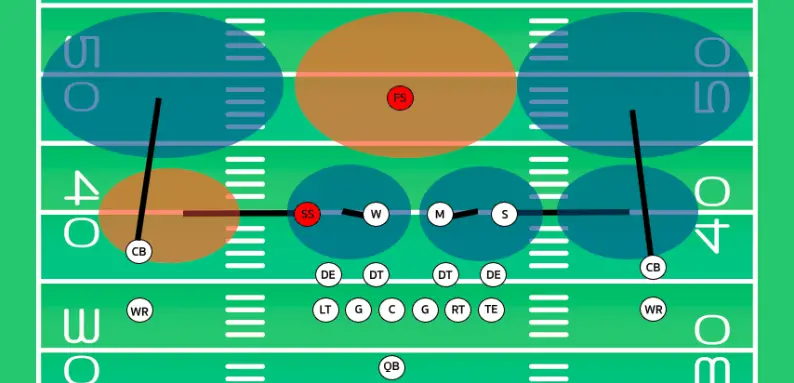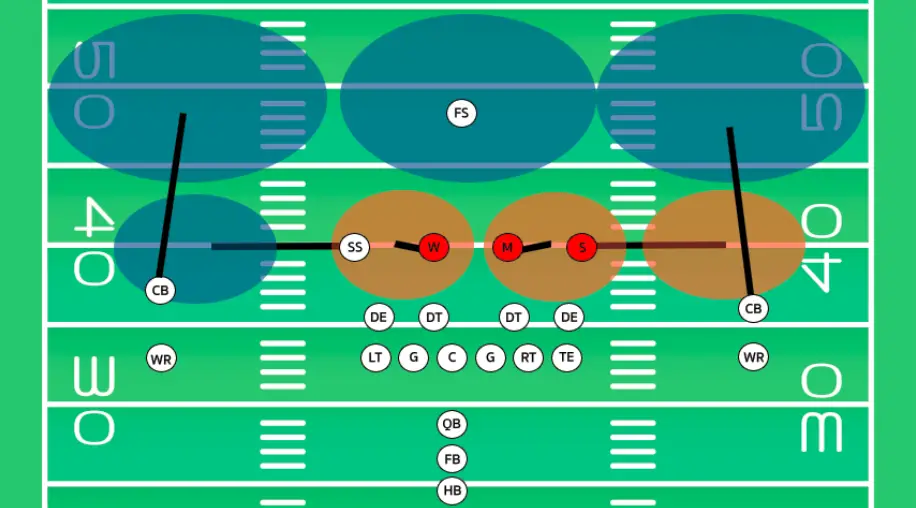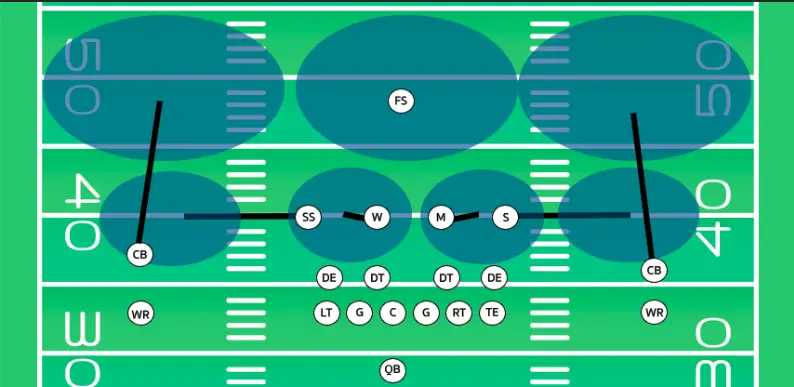Cover 3 in football refers to a zone defense that has three defenders responsible for covering the deep thirds of the defensive backfield. The other eight defenders include four players pass-rushing and four players playing underneath zones.
Cover 3 defenses can be quite effective against the run. The strong safety playing closer to the line of scrimmage means there are more players close to the line of scrimmage.
In pass defense the players in the underneath zones can struggle to cover the width of the field with four players. This can leave the cover three defense susceptible to underneath passes.
This article is going to explain how each how the cover three defense works. As well as a breakdown of what each position group is responsible for in this defense.
How the cover three defense works
In short the cover three defense place three defenders deep making it difficult to complete any long passes. This then allows the safety to move towards the line of scrimmage and help in the run defense.
The defensive line pass rushes with a four-man front and attempts to contain the run on rushing plays. The three linebackers and the strong safety are assigned underneath zones on passing plays.
To get a full understanding of how a cover three defense works in football you must know how each defensive player contributes to the play.
What we are going to describe is the typical cover three defense. There are variations of this defense that may have players doing different assignments than the one described below.
This is because other versions of cover three require different assignments. What you will see below is the most common form of a cover three defense in football.
Safeties

Safeties in a cover three defense are one of the most important position groups. There are three players which cover deep into the defensive backfield in a cover three defense and one of those is a the free safety.
In this defense the free safety will start the play 12-14 yards back from the line of scrimmage. As the play starts this safety will continue to move deeper into the defensive backfield.
This player is responsible for breaking up any deep passes that are thrown down the middle third of the field.
If the opponents rush the ball the free safety will act as a last line of defense if the ball carrier makes it into the secondary.
The strong safety will move much closer to the line of scrimmage lining up only about five yards back. The strong safety will play an underneath zone closer to the sideline on passing plays.
On rushing plays, the strong safety’s close proximity to the line of scrimmage is going to help in the running game.
Having this safety closer to the line of scrimmage allows the defense to stack the box. Stacking the box in football refers to placing eight defenders in the middle of the field close to the offense line.
With four defensive linemen and three linebackers, there are typically seven players in the box. Once the strong safety moves closer there are eight players in the box.
This makes it much easier for the defense to stop the run. The strong safety will often have to fight through the block of the tight end he is lined up against in order to tackle the ball carrier.
Cornerbacks

The cornerbacks in a cover-three defense are two of the three players that end up playing deep coverage in the defensive backfield.
They will start the play near the line of scrimmage matched up with a wide receiver. The quarterback cannot tell if these players are in man coverage with the wide receiver or playing a zone.
Once the play starts the cornerbacks will backpedal into their deep zone. If the ball is rushed they will be close enough to the line of scrimmage to get involved in the play.
Each cornerback will be responsible for covering one-third of the defensive backfield on their side of the field. The free safety will play between the two cornerbacks covering the deep middle portion of the field.
This means all the cornerback has to do on passing plays is move back into their deep third and make sure no passes are completed in that area.
Linebackers

In a cover three defense the linebackers are going to play the majority of the underneath zone coverage.
Generally, the Mike linebacker and the Sam linebacker will line up in the middle of the defense playing zone coverage.
These players will start the play 5-7 yards back from the line of scrimmage and will move deeper once the ball is snapped.
These middle zone players must make sure no short passes are completed in the middle of the field.
If the ball is rushed by the opponents these linebackers will attempt to step up and make the tackle.
The Will linebacker is going to play the same role as the strong safety except on the other side of the field. This player will have an underneath zone on their side of the field.
If the ball is run the Will linebacker will be one of the defensive players with an opportunity to tackle the ball carrier.
Though since the ball is more often run to the strong side of the formation the free safety is likely to see more action in the run game in this defense.
Defensive line

The defensive line in a cover three defense has fairly straightforward responsibilities.
On passing plays the defensive line is expected to rush the passer. Ideally, the defense will sack the quarterback but forcing a bad throw can be just as effective.
The two defensive ends on the end of the offensive line will typically rush the outside of the pocket against the tackle.
While the defensive tackles will rush the interior of the offensive line. Since there are three IOL (interior offensive line) players the defensive tackles will often see double teams.
This makes it more likely that a defensive end will get to the quarterback compared to defensive tackles.
On rushing plays the defensive ends will look to contain runningbacks and funnel them towards the middle of the defense.
Defensive tackles on the other hand have the responsibility of plugging holes in the line. These players need to determine where their opponents plan to rush the ball and fill that gap up.
This way the running back gets stuck in the backfield hopefully leading to a tackle for loss.
Conclusion
The cover three defense is a popular defensive setup that is used in most levels of football.
It features three deep defenders who break the field down into thirds. The rest of the defenders in a cover three defense are either rushing the passer or playing an underneath zone.
If you want to learn about some similar defensive concepts see our guide to understanding the cover two defense in football.

